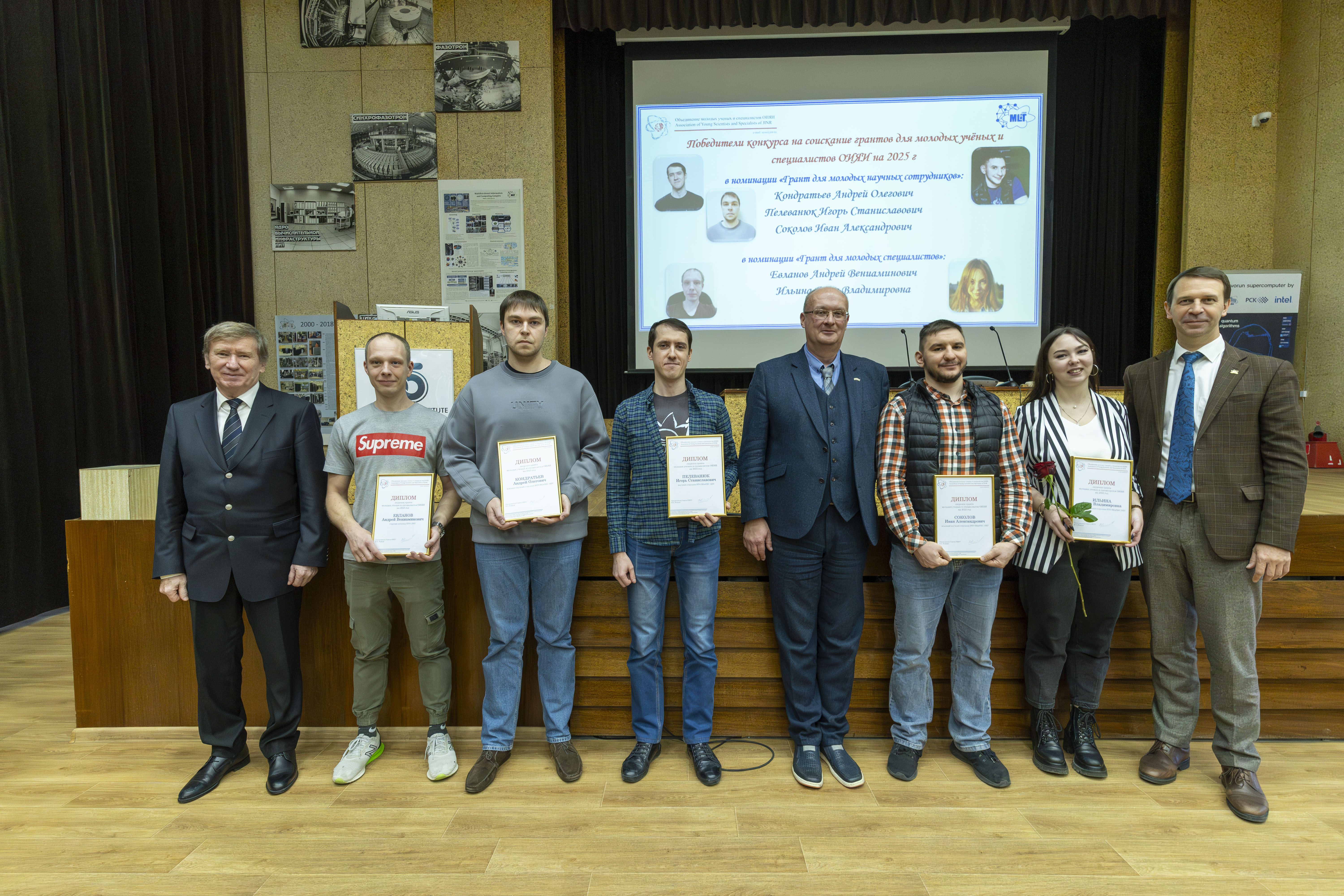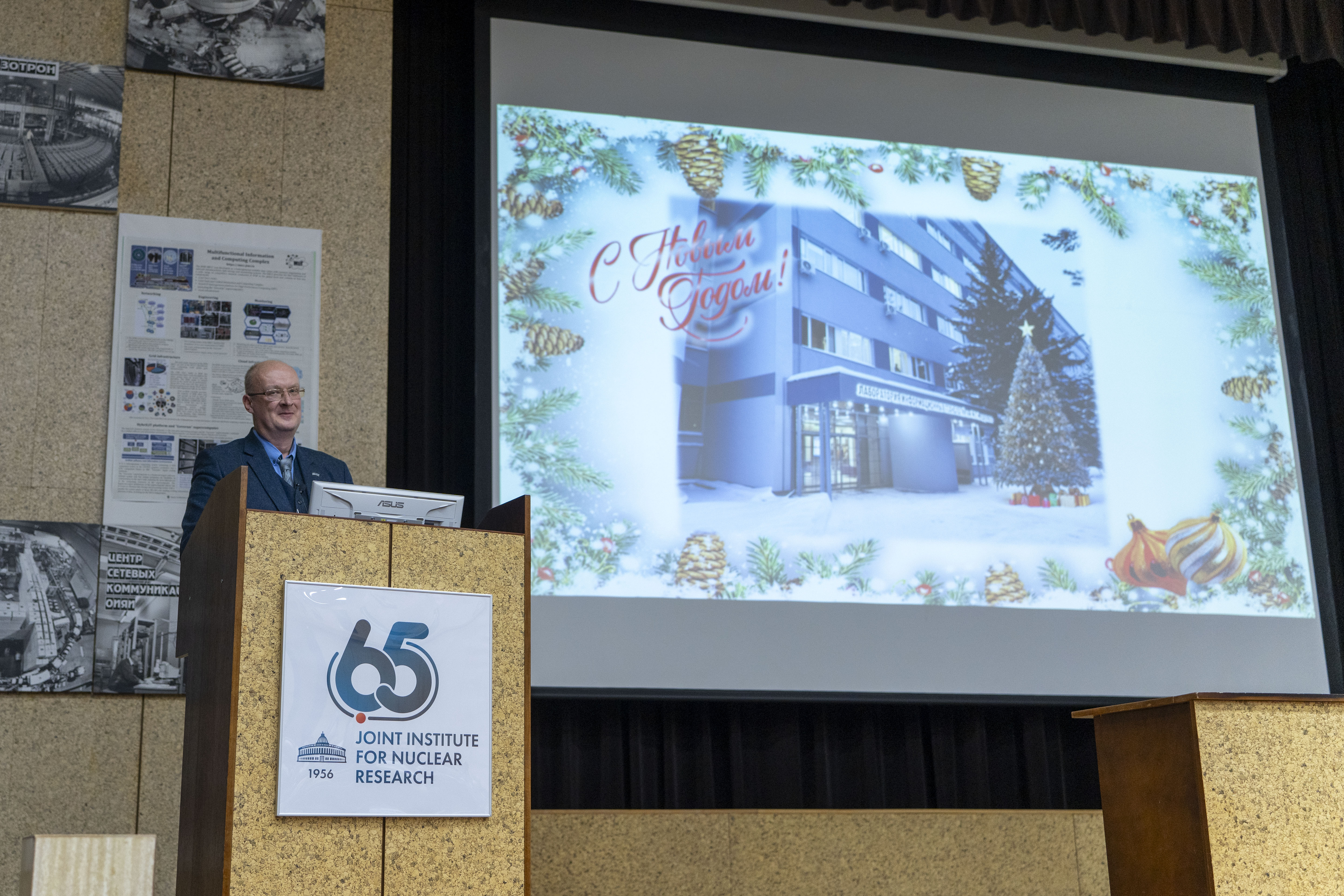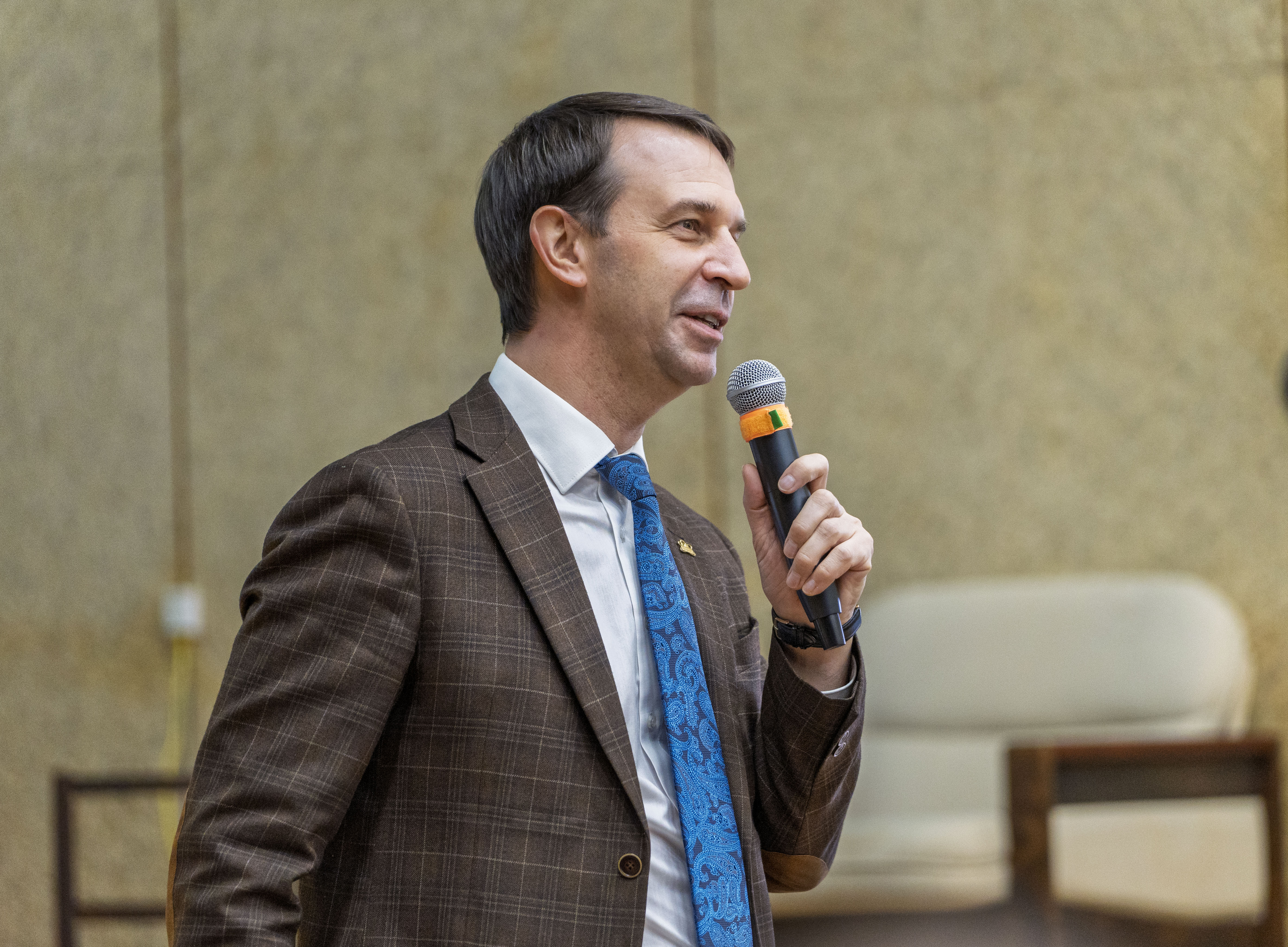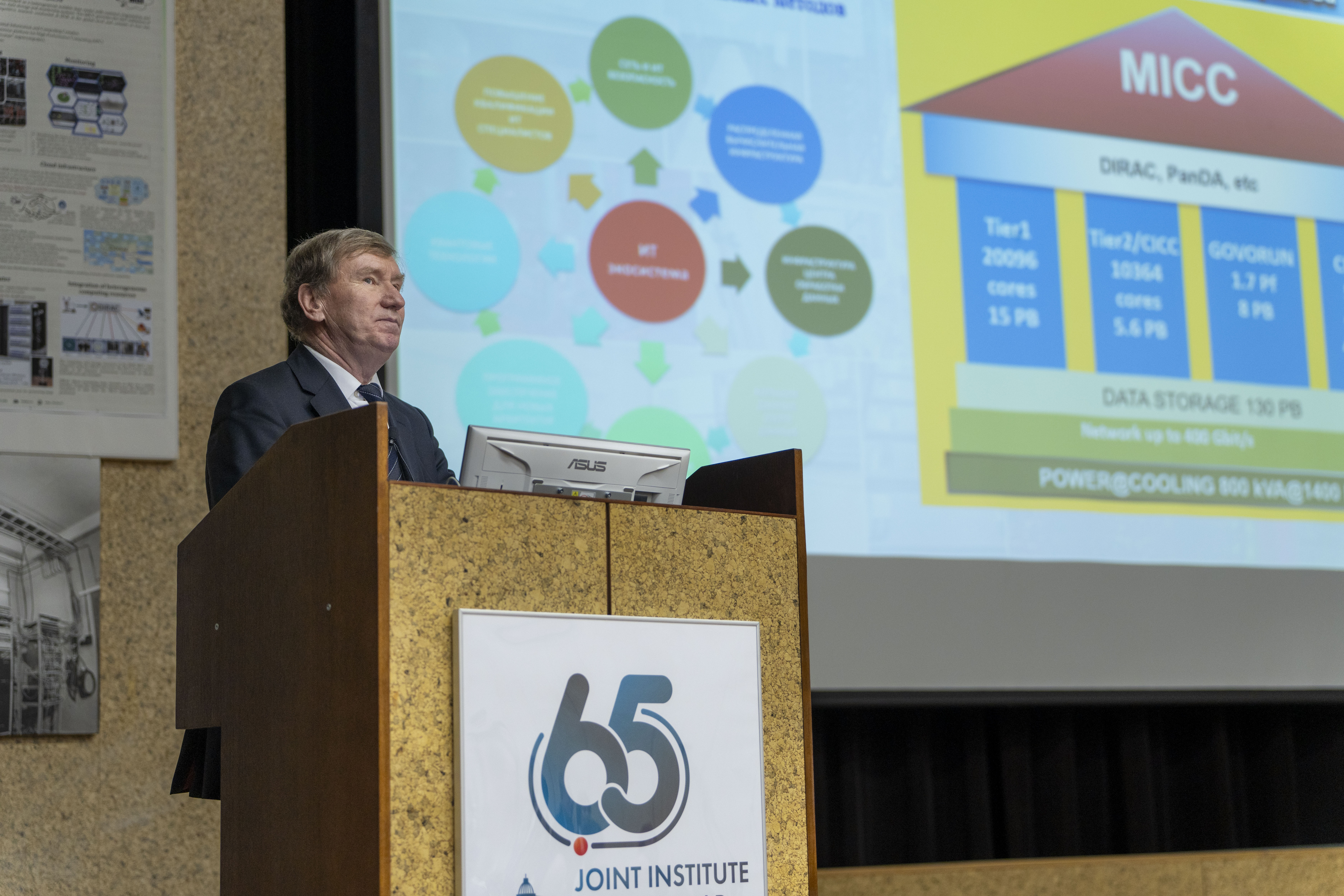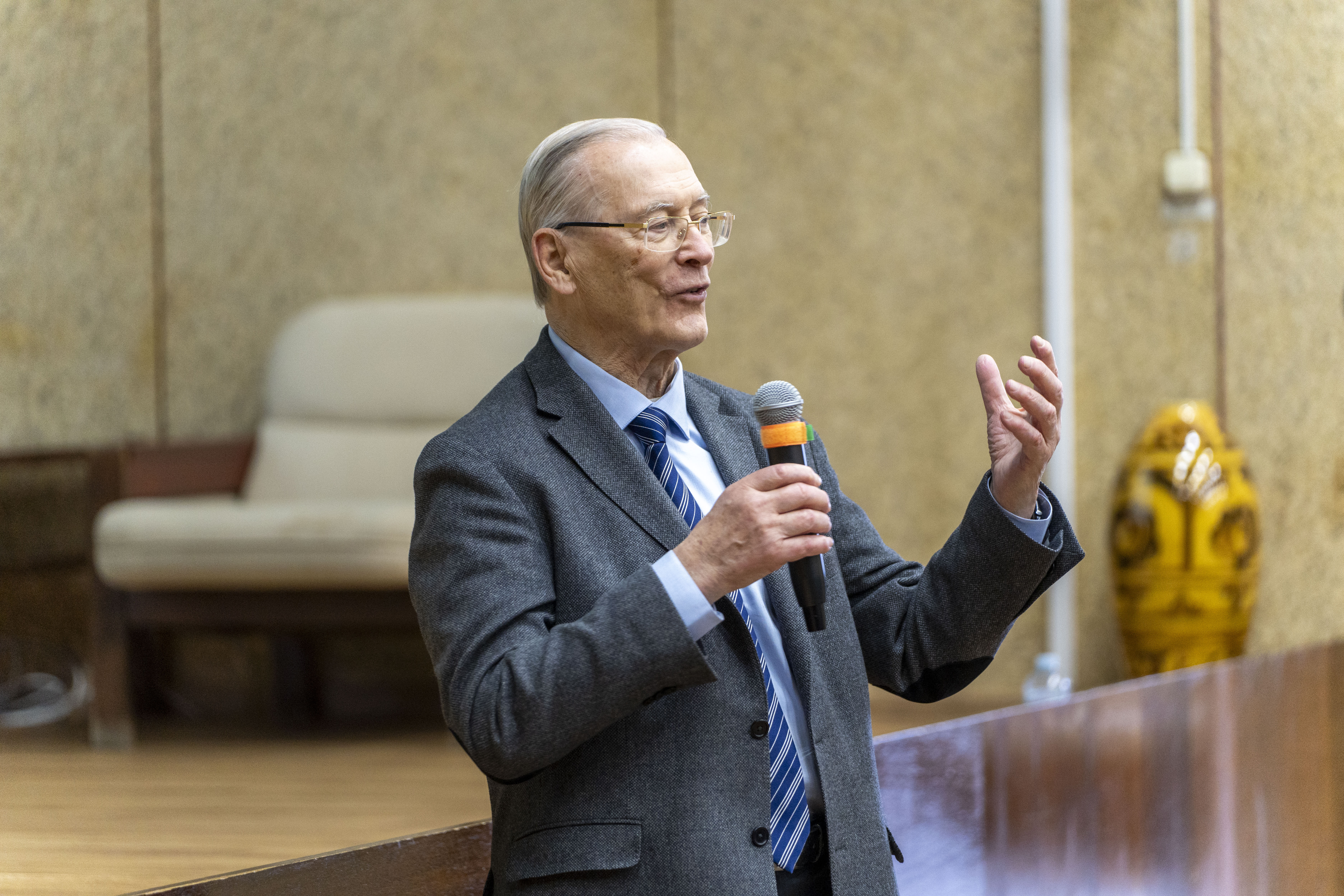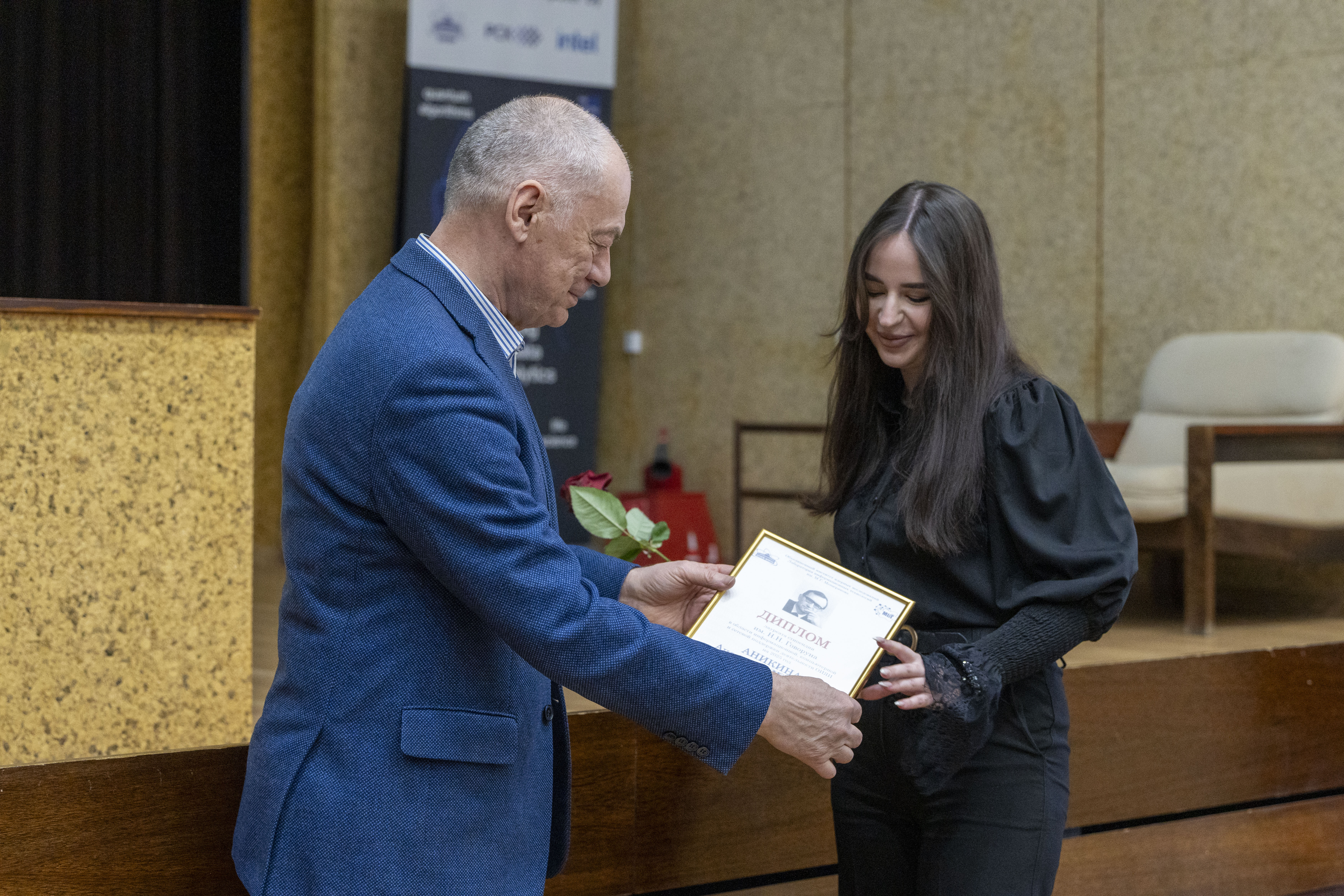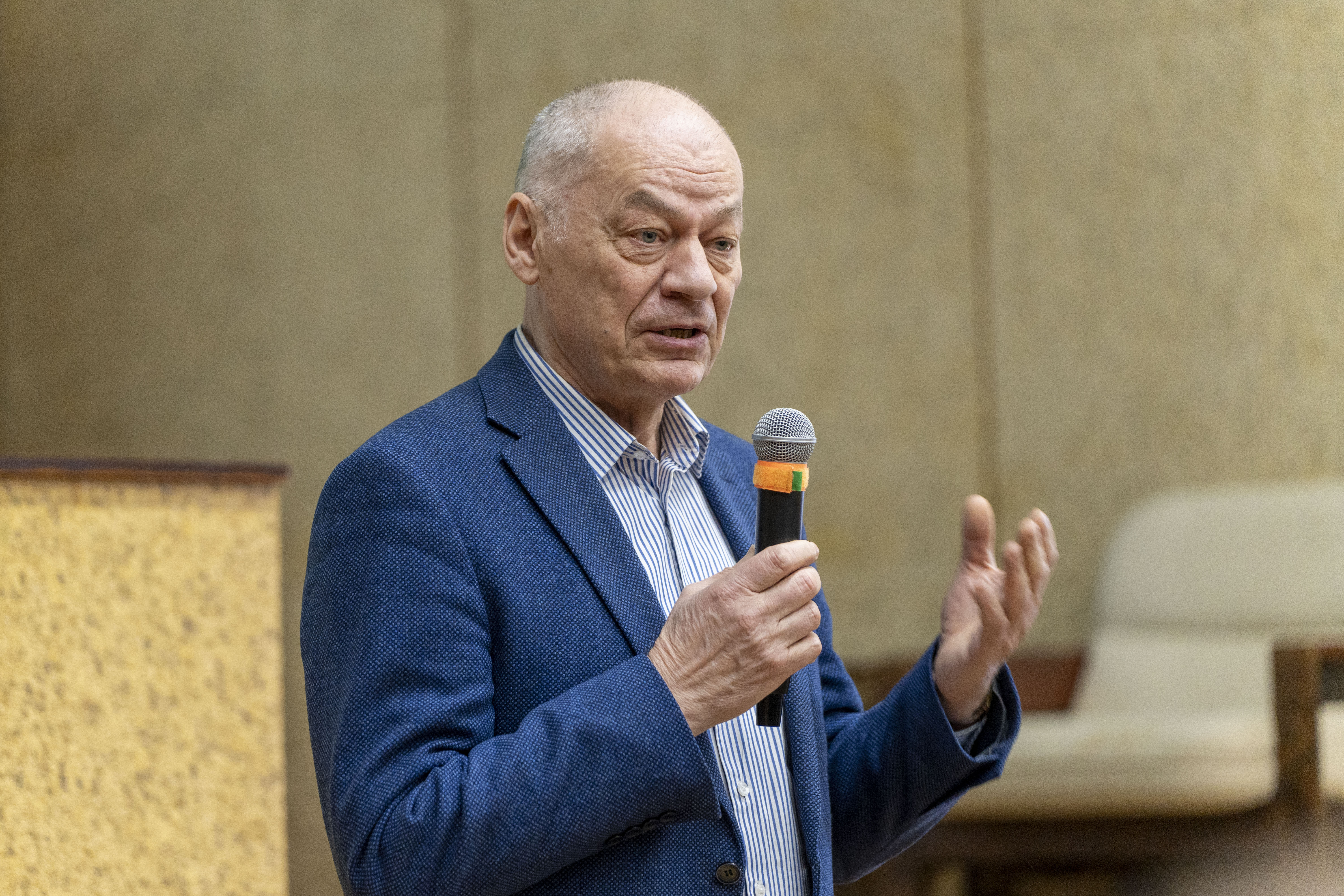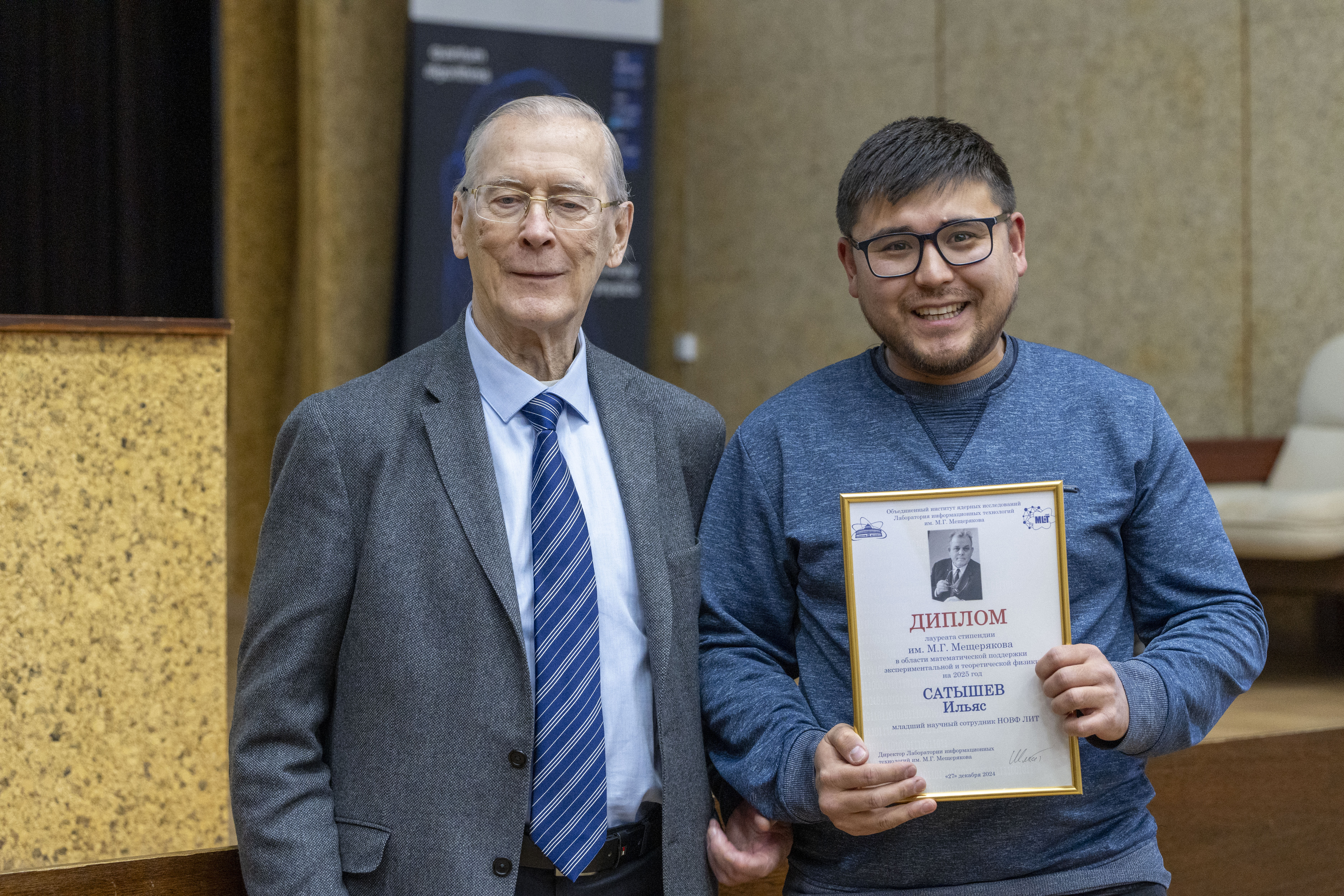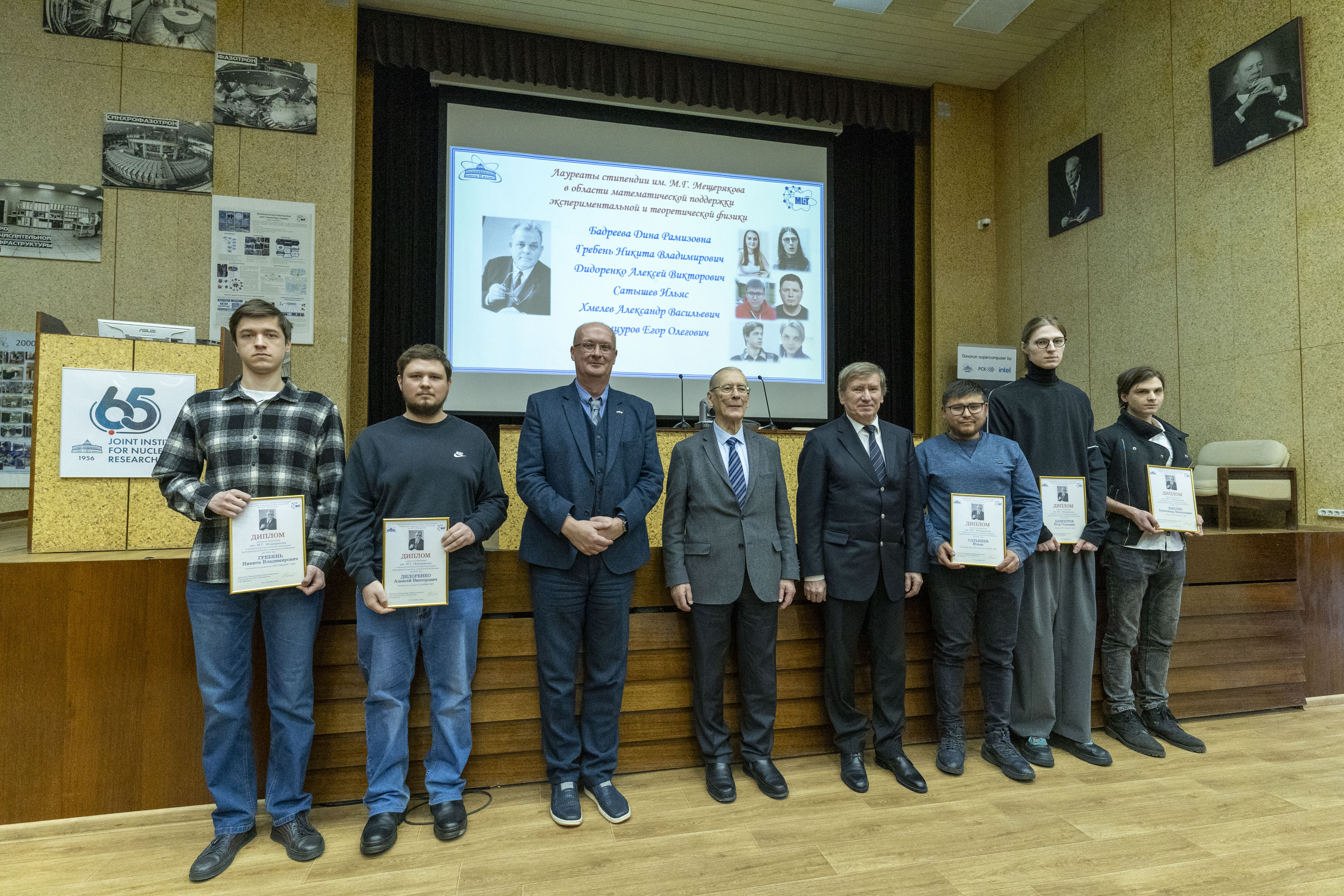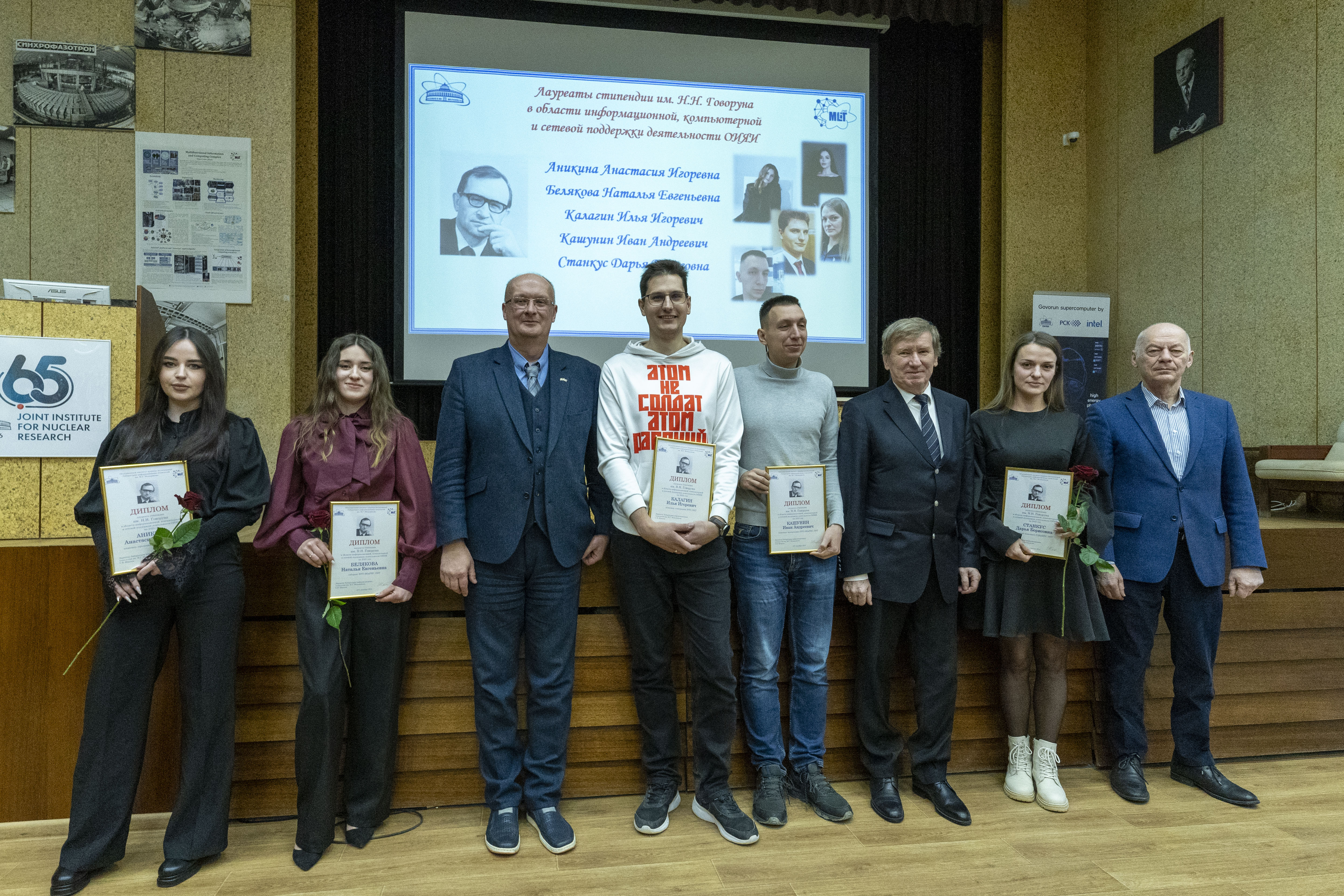MLIT JINR summarised year’s results
News, 10 January 2025
On 27 December, the Meshcheryakov Laboratory of Information Technologies held the annual debriefing with the participation of the JINR Directorate. At the meeting, MLIT Director Sergei Shmatov and MLIT Scientific Leader Vladimir Korenkov presented the main results of the Laboratory’s activities in 2024 and plans for the coming year. The winners of the JINR youth grants and prizes among MLIT researchers were announced.
JINR Director Grigory Trubnikov welcomed the audience: “To my mind, this decade’s currency is data and information, which is why it is symbolic that this meeting is taking place at our Laboratory of Information Technologies. You are our primary information platform. You promote and support science thanks to the telecommunication channels created and the absolutely fantastic opportunities for data analysis, storage, and transfer. Through data, through digital JINR, you bring us closer together. I congratulate you all on the upcoming New Year. I am grateful to you for the past year, all the results, your work, and your talents. I wish the Laboratory to grow consistently, get more and more specialists from the Member States, and be at the forefront of the Institute’s development.”
JINR Scientific Leader Victor Matveev and JINR Vice-Director Vladimir Kekelidze expressed congratulations and warm wishes for scientific success in the coming year.
“MLIT is actively developing. It is a sought-after leader in the field, one of the organizers of the Institute’s activities. I would like to note the great contribution of the MLIT Directorate in maintaining an environment that promotes friendly interaction in the name of the Laboratory’s objectives,” Victor Matveev pointed out.
“With NICA’s upcoming launch, the next year will be special for the entire Institute and for your Laboratory, and we expect even more computational power from you. This is one of the many challenges you will face in 2025, and we are confident that you will overcome all of them,” Vladimir Kekelidze highlighted.
MLIT Scientific Leader Vladimir Korenkov started summarising the Laboratory’s results. The first thing he noted was the large research infrastructure project of the Laboratory, the Multifunctional Information and Computing Complex (MICC). In 2024, a lot of work was done to enhance the MICC engineering infrastructure./p>
In 2024, the Laboratory successfully ensured the reliable and sustainable operation of the major systems, namely the Tier1 and Tier2 data processing centres, the cloud infrastructure, and the Govorun Supercomputer. In 2024, JINR Tier1 for CMS was ranked first among all sites of the experiment worldwide in terms of the CPU time for data processed. The JINR Tier2 output is the highest in the Russian Data Intensive Grid.
Significant efforts were made to develop the JINR Digital EcoSystem. The JINR employee database, PIN-2, underwent a major update. At the beginning of 2025, the JINR scientific publication repository starts working.
Speaking about objectives for 2025, Vladimir Korenkov highlighted the provision of high-speed network communications between Russia and other countries. Due to Russia’s participation in CERN having been discontinued, the leading role in ensuring the operation of external networks, which Kurchatov Institute National Research Centre used to play, will now belong to JINR with the support of National Research Computer Network of Russia. The RDIG-M Consortium is being transformed to develop the distributed computer infrastructure that integrates key centres participating in Russian megascience projects. JINR, together with NRC KI and the Institute for System Programming of the Russian Academy of Sciences, will become the core of this integration.
Among other tasks for 2025, Vladimir Korenkov noted the development of approaches to monitoring the computing, engineering, and network infrastructures using digital twin technology.
On 6 December 2024, the Dubna Branch of Moscow State University received the license for a new Master’s programme in specialty 01.04.02, Applied Mathematics and Computer Science. The first students will enroll next year. “We are glad to receive this license, we find it very important. Getting to train Master’s students ourselves will ensure they will go on to become professionals whose skills we will be confident in and who will involve in solving the Laboratory’s tasks,” the MLIT Scientific Leader highlighted.
The biannual MLIT Schools og Information Technologies, the Workshop on Mathematical Problems in Quantum Information Technologies (MPQIT-2024), and the International Conference on Mathematical Modelling and Computational Physics (MMCP-2024) were among the most notable events held by the Laboratory in 2024. Next year, MLIT is set to hold the anniversary seminar to mark the 95th birthday of Nikolay N. Govorun (18 March) and GRID’2025 11th International Conference “Distributed Computing and Grid Technologies in Science and Education” (July).
MLIT Director Sergei Shmatov gave the next talk on the Laboratory’s 2024 achievements. “The priority objective for MLIT is to provide computational support for the development and implementation of the physics programme of large-scale research projects conducted at JINR and other scientific centers with the Institute’s participation,” Sergei Shmatov pointed out.
Much effort was focused on developing a distributed experimental data processing and analysis system for the experiments at the NICA Collider. The system is based on the DIRAC Distributed Computing Platform and works with the BM@N experimental data, MPD and SPD modelling data. In addition, when speaking of MLIT’s most important results, Sergei Shmatov highlighted the creation of a prototype distributed experimental data processing and analysis system based on the PANDA System for SPD. The prototype was successfully tested on the integrated resources of MLIT and Konstantinov Petersburg Nuclear Physics Institute. In addition, the laboratory created OnLine Filter (a primary data processing system) and cooperated with DLNP to develop a testbed for developing and debugging the data acquisition system, with both projects intended for the SPD Experiment.
The Baikal-GVD, JUNO, and NOvA Neutrino Experiments are currently the main users of the Distributed Information and Computing Environment (DICE) based on DIRAC, which integrates the clouds of the JINR Member States’ organizations.
Two important results were achieved in the Laboratory’s continuous active participation in the collaborations of the LHC Experiments. Together with BLTP and VBLHEP, new constraints on the cross sections of interaction of dark matter particles with Standard Model particles were obtained in the CMS Experiment when processing LHC RUN2 data at 13 TeV. In cooperation with Scobeltsyn Nuclear Physics Research Institute and the Institute for Theoretical and Experimental Physics, promising results were obtained in searching for a 28 GeV resonance in the two-muon decay mode using CMS data in RUN2.
In addition, Sergei Shmatov noted the Laboratory’s ongoing work in analysing LHC open data, developing systems for processing and analysing Baikal-GVD, OLVE-HERO, and TAIGA data, engineering a prototype model of a digital tracking calorimeter (GATE package) based on GEANT4 on the HybriLIT Platform, creating algorithms for searching clusters in SPD, adjusting the GEM Detectors of the BM@N Facility, and tracking particles for CMS.
A lot of outstanding research was conducted by MLIT specialists under the supervision of Jan Busa on developing computational physics methods to study complex physical systems. Several works were included in JINR’s official report to the Russian Academy of Sciences. Most of the research focused on calculations in scientific applications aimed at finding stable energy states in the Ising model and at studying collective effects in the atomic nucleus model. Together with colleagues from South Africa, the researchers conducted a numerical study of spherically symmetric standing waves in a ball, considered as an approximation of weakly radiating oscillons in the ϕ4 theory.
Together with LRB, MLIT develops online services of the BIOHLIT Project in the ML/DL/HPC Ecosystem of the HybriLIT Platform. In life sciences, the Laboratory focuses on using artificial intelligence to solve various tasks in agriculture. An application for detecting plant diseases has already created, and work is underway to use AI technologies and Earth remote sensing data to predict the state of the environment. In cooperation with BLTP, Josephson junctions are being modelled in the ML/DL/HPC Ecosystem of the HybriLIT Platform. An interlaboratory working group on modelling radiation conditions at the NICA Accelerator Complex (consisting of researchers from MLIT, LRB, VBLHEP, FLNP, and Radiation Safety Department) is assessing the radiation situation in the premises of the NICA temporary control room. To ensure high-energy neutron dosimetry, two methods for reconstructing the neutron spectrum based on readings from the Bonner multisphere spectrometer were developed.
Sergei Shmatov noted that the result of 2024 MLIT activities was the publication of over 150 scientific papers, three monographs, and about 100 articles as part of international collaborations. The Laboratory’s employees gave over 140 talks at international and Russian conferences.
Speaking about plans for 2025, Sergei Shmatov highlighted preparations for processing the MPD experimental data, modernising MICC, and attracting new personnel. The Laboratory will develop a concept network infrastructure and ways to integrate the resources of the RDIG-M Consortium. Other plans include working on processing and analysis systems (NICA and LHC Experiments, Neutrino Programme), information and analysis systems, data processing and analysis methods and algorithms (especially promising ones based on AI), computational physics methods to study complex systems, and the JINR Digital EcoSystem. In addition, in 2025, the Laboratory will start preparing for celebrating its 60th anniversary.
The discussion of the results of the MLIT activities were concluded by a ceremony of awarding the winners of grants of the Association of Young Scientists and Specialists of JINR and of Meshcheryakov and Govorun Prizes.
